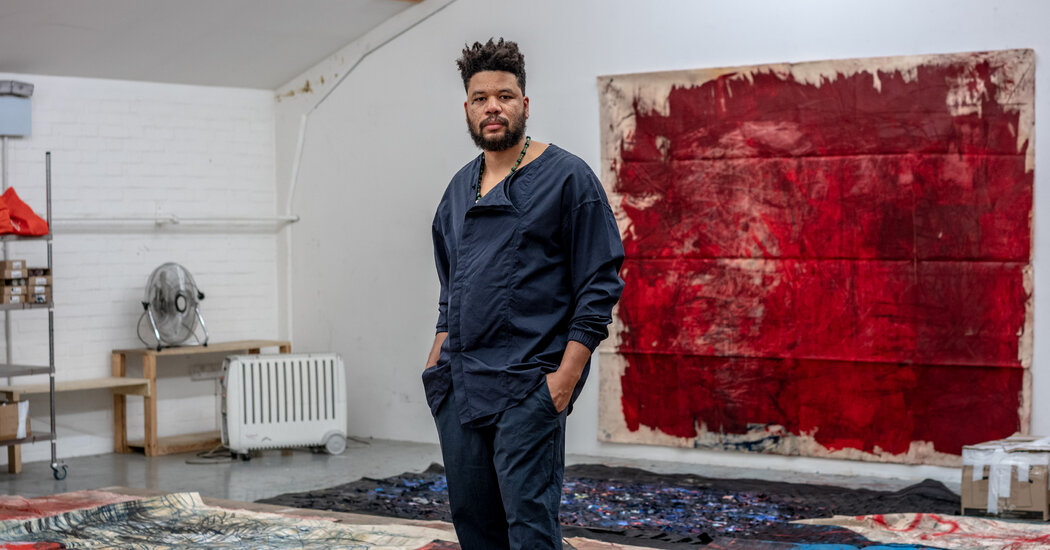
LONDON — When he was a boy, Oscar Murillo told his best friend he was moving to London, but his buddy refused to take him seriously: Their tight-knit community in southwestern Colombia was the sort of place families stayed for generations, where almost everybody worked at the candy factory that dominated the town’s economy.
The news, however, was true. In the 1990s, the 11-year-old Oscar left La Paila, Colombia, and arrived in East London, where his parents took jobs as office cleaners.
Speaking little English and having been displaced, he took refuge in drawing. These early scribblings pointed Mr. Murillo to painting, which in turn led to a multimedia art practice and, in 2019, to his winning the Turner Prize, one of the art world’s most prestigious honors.
But the memories of La Paila, and of the succor he found in those early doodles, still inform his work, which now hangs in major museums around the world. His canvases, multilayered patchworks of color that can also include glued grime and supersize Spanish words, now fetch $300,000 or more at auction.
“My work is a social detonator,” said the soft-spoken Mr. Murillo, a way for the son of working-class immigrant parents to blast through the barriers surrounding a social class that typically denies entry to people like him. “It’s a way to infiltrate the system.”
While some might see a contradiction or even hypocrisy in an artist earning so much to send a socially conscious message, critics see it differently.
“Yes, his work is relatively expensive, but it is also anchored to the exploitation of labor in global markets,” said Linda Yablonsky, a noted art writer. “It calls attention to it through his materials and his working process.”
As an example, in his first significant solo exhibition in New York in 2014, he reconfigured the gallery into a working replica of the chocolate factory of his childhood, as a way to highlight social inequities and post-colonial economies.
His enormous studio in industrial North London, where he not only paints but also works in sculptural installations, video and other mediums, has a more conventional look, filled with stacks of canvases. But the unexpected twist is that many hundreds of these paintings were not created by Mr. Murillo — but by children from around the world.
In 2013, he sent blank canvases to La Paila so the children there would have something to express themselves on. Next, he sent canvases to schools in Zambia, then Kenya.
Mr. Murillo has since made available more than 40,000 canvases whose empty spaces have been filled with the creative efforts of children in 34 countries.
As Mr. Murillo strode around his studio on a crisp November day, he stopped before some of the canvases and brought out ones from children in Mumbai, whose use of color he particularly admired.
“The idea is to let these kids explore in the intimate reality of the school desk, to make marks of their own desires,” he said, adding that he sees the canvases as “recording devices” absorbing the children’s thoughts. “The truth of a society comes out naturally.”
The canvases, which are collected after acquiring months’ of patina in students’ classrooms, have been exhibited at major art venues and triennials on three continents, and are being digitized.
It is important to Mr. Murillo that the canvases “weren’t treated paternalistically as children’s drawing,” said Clara Dublanc, a co-director of Frequencies Institute, as the nonprofit project, a work in progress, is known.
While Mr. Murillo, 35, left Colombia a quarter-century ago, his studio can feel like an extension of his homeland. Some studio assistants are from La Paila. Chitchat is about Colombian soccer scores.
If he had grown up in La Paila, Mr. Murillo imagines he would have wound up either as a “factory worker or ‘sicario,’” a hit man.
His childhood friend Yeison Murillo (not a relation) spent 12 years as an adult pouring chocolate powder into a machine until he was fired and immigrated to Seattle.
On the phone from the United States, he said he remembered when Mr. Murillo returned at 17 for a visit to La Paila.
“Oscar came back with big hair and big ideas,” said Yeison, who added that he did not pay much attention to the lofty conversation because his friend “still wanted to play soccer without shoes.”
But Mr. Murillo’s artistic ambitions were serious, and he earned an M.F.A. at the Royal College of Art, helping pay for his tuition by working as a cleaner.
An advanced degree, however, was no guarantee of success in London’s crowded art world, where he was just another graduate struggling to find a gallery. He often hung out at exhibition openings.
“There was something different about him,” recalled Tom Cole, a gallerist who met him in those lean years. “Chatty. Forthcoming.”
Curious, Mr. Cole asked for a studio visit; Mr. Murillo invited him to a home-cooked dinner as well.
“He was very engaging with very strong opinions about what art should be,” said Mr. Cole, now a co-owner of the Sunday Painter gallery in London. “How important it was for art to have a social and political role and how art was lacking that.”
Adding a communal element to his art helped him land his first shows, and a collaborative approach has been a signature part of his practice ever since: Mr. Murillo proposed to Mr. Cole that he cook at his gallery the same arepas and tamales that he had just made for him.
“The show brought a big crowd and was fun,” Mr. Cole said of the 2011 exhibition. “He was really interested in the communal aspect of bringing people together.”
Mr. Murillo was also interested in colliding together worlds that otherwise would probably never intersect: like art-world insiders and Colombian-born cleaners.
These were the early signs of what Mr. Murillo calls his “infiltrations,” like, he said, when “a collector in the United States sees the word ‘tamales’” floating on his wall in a six-figure painting in an expensively styled home.
Mr. Murillo soon grabbed the attention of the blue-chip David Zwirner gallery, which added him to its roster and still represents him.
“He had a meteoric ascent, a justified ascent,” Mr. Cole said, adding that Mr. Murillo had achieved both commercial and critical appeal. “Few artists manage that,” Mr. Cole said. “Murillo does both.”
One thing Mr. Murillo does not do, in his own words, is American-style identity politics.
“The only experience that counts seems to be the American one, and that is not my experience,” Mr. Murillo said. “The world is a broader landscape. Where is Brazil? Where is Colombia in the race conversation? I prefer not to enter that conversation as it stands today. I find it ultimately divisive.”
That’s not to say Mr. Murillo does not consider his art politically charged. But he views his preoccupations through that most English of lenses: “I prefer to talk about class,” he said, which he considers a more universal struggle.
While exhibiting from Paris to Tokyo, there was one place he remained largely unknown: Colombia.
For the past seven years, María Belén Saéz de Ibarra, a Colombian curator, has been working to change that, planning a Murillo exhibition at the National University of Colombia in Bogotá. The show, “Conditions Yet Not Known,” finally opened in October.
Ms. Saéz de Ibarra remembers his arrival: “He opened his suitcase and out came a black cloth,” she said, referring to one of the unstretched canvases that Mr. Murillo is known to hang like drooping flags in art pavilions. “He is a planetary nomad carrying his pain around the world.”
When the time came to install the show, sometimes violent street protests over inequality and police abuses were rocking Colombia. Mr. Murillo invited student leaders from the protests to help set up the exhibition. “They were in danger. It was my way to get engaged,” he said.
While there, Mr. Murillo saw some of the discrimination that the millions of displaced Venezuelans who have arrived there are experiencing, even in La Paila.
“Ironically, in Colombia, I’m most sympathetic with the Venezuelan,” he said. “As a migrant, I understand what they are going through.”
The struggles he faced growing up have stuck with him and influenced his politics and art, but he has become leery of dividing the world too neatly.
“I knew the oppressor and I romanticized the oppressed people,” he said. “But the oppressed can become monsters, too.”







